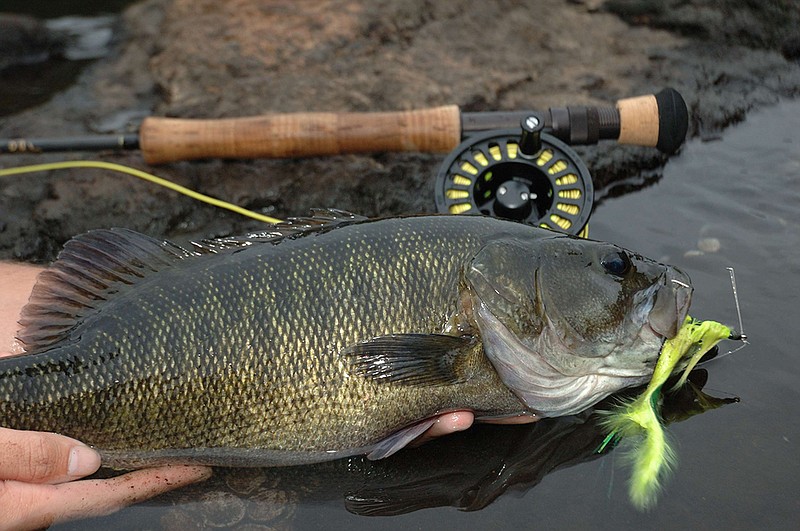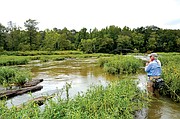The fight didn't last long, maybe a couple of minutes, but it was exciting. Between several bulldog runs that stripped line from the reel, the fish broke the surface and walked on water, shaking its head in anger at a wad of foam and feathers that pierced its lip.
All that tail-walking must have sapped its strength. With fury depleted, the fish allowed itself to be steered out of the current. Kent Edmonds pinched its lower lip between his thumb and forefinger, and a broad grin broke across his face as he carefully lifted a chunky shoal bass for appraisal before release.
It was a decent fish, maybe 14 inches long with a guesstimated weight of a pound and a half. Still, on a 6-weight fly rod, the strength of the fight rivaled that of a largemouth bass twice its size. Shoal bass are aggressive and pugnacious. They are the most intriguing sport fish you've probably never heard of.
Shoal Bass
Fishing for shoal bass is so much fun, especially with a fly rod. They exhibit the aggression of more well-known black bass, like largemouth, smallmouth and spotted bass, yet their preferred habitat is in rivers, in the swiftwater shoals other bass avoid. Like trout, they hover in current breaks and dart out to grab prey items adrift in the current. They readily attack topwater lures and flies, and they grow to record weights approaching nine pounds.
With all that going for it, the relative anonymity of shoal bass is due to geography. There is only one small slice of the world where they exist. The species is native to the Apalachicola-Chattahoochee-Flint (ACF) River Basin, where it evolved isolated over millennia to thrive in warm-water shoals of the Piedmont and Coastal Plain.
Up until 1999, the shoal bass wasn't even an official species. Science considered them a subspecies of the redeye bass native to Alabama's Coosa drainage. The tools of modern genetics verified what local anglers and biologists had known all along. Shoal bass are a different animal. Among other traits, they grow much larger than other little bass species, like the redeye, which fill the shoal-habitat niche in Southeastern river systems.
"Shoalies" reach lengths up to 24 inches, and anglers regularly catch 2- to 5-pounders. A new Georgia state record was caught from the Chattahoochee River near Columbus, Georgia, in December. It weighed eight pounds, five ounces. The IGFA world record was an 8-pound, 12-ounce monster caught from Florida's Apalachicola River.
These feisty fish are the heavyweight champ of the different river-bass species, and if not for one particular waterway, the champ would be up against the ropes and in trouble.
Across the ACF River Basin, extensive damming over the last century turned most of the system into a series of reservoirs connected by dam-controlled stretches of river. Shoal bass still exist across the drainage, but the habitat is dramatically and permanently altered. Slower, deeper waters have allowed non-native species like spotted and smallmouth bass to out-compete and interbreed with shoal bass.
The largest remaining unaltered native stronghold for the species is the upper Flint River. It should come as no surprise that the Flint is arguably the best shoal bass fishery in the world.
The Flint River
About four hours drive time south of Chattanooga, I met Kent Edmonds on the courthouse square in Thomaston, Georgia. Edmonds has guided fly fishers on the Flint River for about 30 years, and while he won't admit it, he's largely responsible for the river's sterling reputation in the fly fishing world.
Edmonds moved to rural Upson County in the 1980s for work, and it took him away from the Carolina mountain trout he loved. So, like any good angler, he set out riding the roads in search of a fish to catch.
"I went over the bridge one day on the Flint, and... man... I couldn't believe my eyes," he said. "It looked like North Carolina or Virginia. This was before the internet and before the shoal bass officially was a species. I didn't know anything about it, except that the water was pretty and it looked more like a trout stream than it did like a central Georgia river.
"So I grabbed a fly rod, Woolly Buggers and some big stoneflies, and started fishing. I caught some redbreast, caught these bass that - I don't know - I didn't know what they were. But I was hooked."
The Flint River is like a snapshot back in time. Twisting through the pine forests of the middle Georgia countryside, it must look much as it did when ancient woodland tribes built stacked-stone fish weirs, presumably to trap shoal bass, catfish and redbreast sunfish. Remnants of those weirs still exist in the river, looking like shoals too symmetrical to be natural.
The Flint is one of only 40 rivers in the United States to flow undammed for more than 200 miles. Its headwaters emerge from a pipe under the tarmac of the Atlanta airport, but after that it largely escapes civilization for some 220 miles down to its first impoundment at Lake Blackshear, northeast of Albany, Georgia.
There's a sweet spot for fly fishers in the middle of this long run at a geologic formation known as the Fall Line. The Fall Line is where the Piedmont gives way to the Coastal Plain. It is the coastline of an ancient sea that cuts a 20-mile-wide swath of rapid elevation loss across the region, east to west. For the Flint, the Fall Line features a 45-mile stretch of river with shoal-broken habitat perfect for wading anglers and shoal bass.
When Edmonds parked his old Jeep Cherokee at the end of a steep red-dirt road, we looked out over a river that was wide and shallow. Bedrock shoals and wooded islands braided brown water into twisting channels. Tall green grasses grew from the silted-over stone at the river bends, where dragonflies with accents of blue and red chased each other through heavy summer air. As one of Edmond's clients was amazed to note, this is a place where Spanish moss and mountain laurel co-exist.
And the fishing was exceptional.
The Flies
Shoal bass are not picky about what they eat. Their diet is primarily made up of smaller fish, crayfish, mean-looking 2-inch-long aquatic monsters called hellgrammites and dragonfly nymphs. Any streamer or topwater popping bug will draw strikes. Spin-fishers do well with small spinnerbaits, crankbaits and soft-plastics on jigheads.
There are a couple flies, however, that you'll find in the boxes of every serious shoal bass angler. The first is a floating foam pattern called a Stealth Bomber. Edmonds invented this fly, and it has become THE shoal bass pattern. When stripped, the Stealth Bomber makes a little "bloop" bubble on the surface and then dives and wiggles, leaving a trail of tiny air bubbles. Shoalies, bream and other bass species can't resist it.
The second fly that's almost a requirement on the Flint River is a pattern dreamed up by another renowned local angler, Carter Nelson. Nelson's Rubber Legged Dragon (RLD) is a weighted dragonfly nymph. It has proven effective for shoal bass and pretty much everything else in freshwater.
Where to Go
The Fall Line section of the Flint River stretches between the towns of Gay and Carsonville, Georgia. Thomaston is a good base camp, and there is riverside camping available at Sprewell Bluff Park about 15 minutes outside of town. There are good shoals to wade at Sprewell Bluff as well as downstream at Big Lazer Creek Wildlife Management Area. Access to other shoals requires a float trip.
Six public access points offer several different options for float trips in kayaks, canoes or rafts. The river is too shallow and rocky for larger vessels. Flint River Outdoor Center offers shuttles as well as canoe rentals. Look them up on Facebook.
For more information on access points and fishing the river, check out Edmond's website at flyfishga.com. Edmonds has drive-in access through private land to a great stretch of shoals for his clients, and a guided trip dramatically cuts the learning curve for anglers new to the river.
Nick Carter is the author of "Flyfisher's Guide to North Carolina & Georgia." The guide is available on Amazon.com, and autographed copies are available by emailing the author at nsc8957@gmail.com.

